Berkeley Welcomes Record Number of MBAs in for Class of 2020
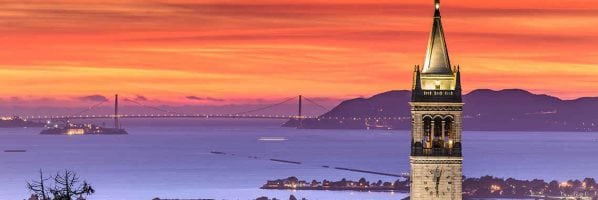
Last week, UC Berkeley’s Haas School of Business unveiled stats for the incoming students that comprise its full-time MBA Class of 2020.
With 291 full-time MBA students (along with 276 evening and weekend students), the Berkeley Class of 2020 is larger than any before.
The new class one of the most academically accomplished in school history. Average GPA for this year’s first-year class is 3.66, off just .05 from last year’s. But an increase in average GMAT offset the tiny backslide in GPA. At 726, it moved up one point higher than last year’s incoming class.
In terms of professional experience, Haas students come from various backgrounds. About a quarter of the students come from the consulting industry, and another 20 percent come from banking/financial services backgrounds. The industries drawing the third-, fourth-, and fifth-most Haas grads are high tech (10 percent), nonprofit (9 percent), and healthcare/pharmaceutical/bio (7 percent). In addition, 5 percent of the incoming class has military experience.
The percentage of women in Haas’s incoming class is also up over the previous year, something we’ve also seen this year at Northwestern’s Kellogg School, Duke’s Fuqua School, and USC Marshall, among others.
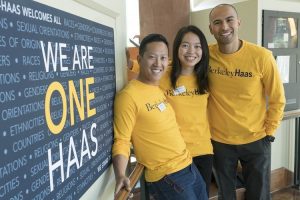
About 43 percent of the incoming Berkeley Class of full-time MBAs are women—a 3 percent increase. International students from 30 countries make up around 34 percent of the class, down from 39 percent last year. Here, too, Haas is not alone. Many U.S. schools have shared, in both in published class profiles and informal conversations, that international application volume was down, or at best, flat year over year.
Former Haas Dean Richard Lyons stepped down in June after 11 years with the school, a role in which he raised more money than any prior dean and oversaw the construction of Connie & Kevin Chou Hall. The addition of the new building helped make it possible to expand the Haas class, an effort Lyons championed. He and other supporters viewed it as a way to help ensure that Haas has enough graduates to command attention from the world’s top recruiters without compromising the intimacy and culture.
“Part of the reputation of the school is a function of its scale, and there are times where you are just not at the right reputational scale. You’re too small,” he explained in a 2017 interview with Clear Admit.
“It’s a super intimate experience—there’s no question about that—but target companies want to go to a place where there are enough people graduating that they can send a team of recruiters, for example. If you are too small you are below the threshold.”
Ann Harrison, a renowned economist and member of the faculty at the University of Pennsylvania’s Wharton School, will serve as Haas’s next dean. Harrison begins her term on January 1, 2019. Professor Laura Tyson, the current interim dean since Lyons left, returns to her prior faculty positions next year.
This article has been edited and republished with permissions from Clear Admit.
In Search of the Best MBA Internships in the Bay Area
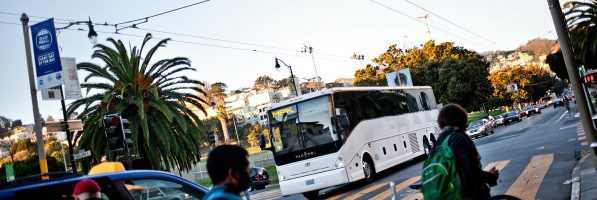
It’s not just the entrepreneurship and technology boom of the past thirty years that has brought San Francisco into prominence as a major city for business. In fact, the city’s legacy as a center for banking and finance can be traced all the way back to the years of the gold rush. From it’s nickname as the “Wall Street of the West” to its role today as a hub for technology and social media companies, San Francisco has long been a city where young business professionals can thrive.
MBA programs in the metro offer opportunities for students to connect with local organizations through Bay Area internships and corporate partnerships. These internship opportunities, the majority of which are arranged through campus recruitment or university networking, frequently open the door for full-time employment and ongoing career training. Below, we’ve rounded up just a few of our favorites.
The Best Bay Area Internships for MBAs
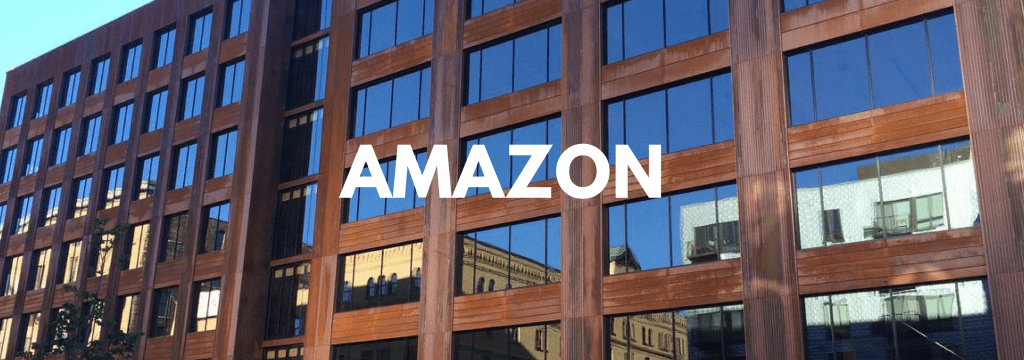
Amazon consistently makes the lists of top employers, both for full-time positions and summer internships, for graduates from universities like the UC Davis Graduate School of Management, SJSU’s Lucas Graduate School of Business, and the Haas School of Business at UC Berkeley.
This likely doesn’t come as a surprise. With an extensive reach into the retail, tech, and entertainment industries, Amazon has made headlines in the past years for its vigorous hiring of MBA students and graduates. In 2015, the company was the number one employer for graduating MBA students, and it doesn’t look like that trend will change any time soon.
Amazon has hired more Haas MBAs for employment and internships than any one company has in recent history (33 in 2017). There are also currently 165 Haas alumni already working at the company, who continue to play a large role in the recruitment and onboarding process for new hires.
One reason that might explain the staggering number of Haas MBAs joining Amazon is the company’s vigorous recruitment process, which begins early in fall and provides practice for case interviews. According to MBA alum Carolyn Chuong, now a Senior Product Manager at Amazon, the Amazon corporate culture and Berkeley’s academic philosophy are a good fit for each other.
“Haas and Amazon have cultures that value feedback,” she said.
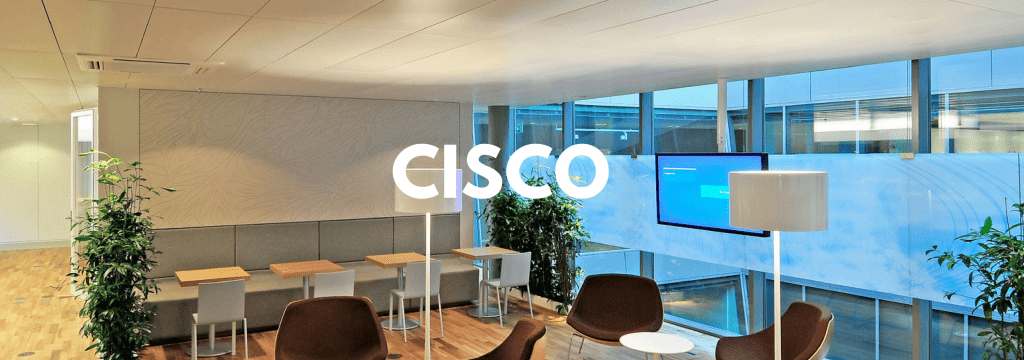
San Francisco’s role today as a hub for technology may help explain why Cisco Systems, an American multinational technology company headquartered in San Jose, is one of the top internship destinations for MBA students at schools like Haas, SJSU, and the University of San Francisco School of Management.
For students both in and out of the tech fields, Cisco offers internship opportunities in fields like marketing, security, supply chain, operations, human resources, and more. Schools like the San Jose State University even offers special opportunities through their corporate partnership with Cisco, such as a unique MS Software Engineering, specialization in cybersecurity available only for employees.
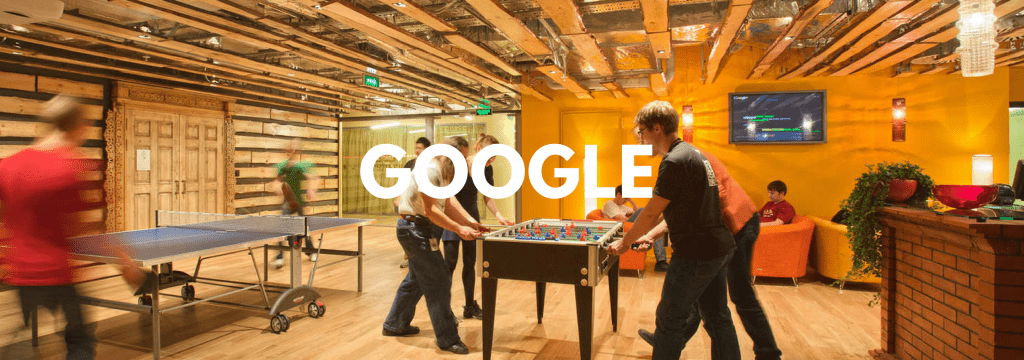
Listed in 2017 as the most visited website in the world, Google seems to have no limits to how far the company might grow. Headquartered in Mountain View, California, Google now employs more than 85,050 people around the globe. Talented MBAs who can break into the company can make, on average, nearly $6,000 per month as an intern, not to mention attractive benefits like free food, gym membership and transportation. Simply put, a stop at Google is one of the most attractive Bay Area internships out there.
Not surprisingly, Stanford University Graduate School of Business and Berkeley Haas have the most alumni currently with Google. San Jose State University and UC Davis grads are also prolific at the company, among other top schools like Cornell, Harvard, and MIT. Landing an internship at Google can be an incredibly challenging process. With high rates of alumni from California schools working at the company, students can leverage their university’s professional network to make connections and get their foot in the door.

Tesla, a multinational corporation specializing in renewable energy, offers a large number of internships and co-ops for MBA students. With its headquarters in Palo Alto, CA, and a commitment to taking on some of the world’s most important problems, it’s understandable why students at schools like USFCA, UC Davis, and SJSU seek out internship opportunities with the company.
“My experiences as a Tesla intern are some that I will take with me for the rest of my career,” one Tesla intern said on her experience. “I had the opportunity to tackle problems that were challenging, unique, and relevant—and within several weeks, I was trained to weigh in on decisions that would affect an entire production line.”
According to Tesla, interns and co-ops will be matched with teams and projects based on their background and career goals. Many Tesla interns have returned to the company in a full-time role after graduation.
The California MBA Program Guide
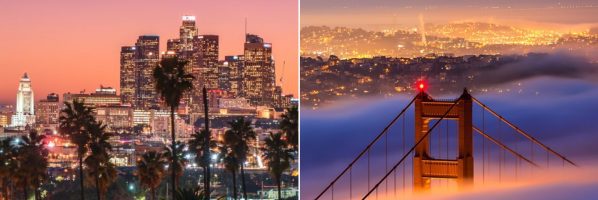
If you’re looking to earn a California MBA, where should you go to school? Should you choose a top MBA program in Los Angeles or San Francisco? Both cities offer beautiful weather, gorgeous beaches, and world-class business education, but is one location better than the other?
Los Angeles vs. San Francisco
To get started, it’s necessary to compare the cost of living in Los Angeles and San Francisco. According to Numbeo, the world’s largest database containing user contributed data about cities, San Francisco is far and away the more expensive place to live. You would need $7,748.24 in San Francisco, CA to afford the same lifestyle that you can have for $5,700 in Los Angeles. That’s just over $2,000 more per month needed to live in San Francisco, and here’s how that’s broken down.
- Consumer Prices:98 percent higher in San Francisco
- Rent Prices: 51 percent higher in San Francisco
- Restaurant Prices: 62 percent higher in San Francisco
- Groceries Cost: 8 percent higher in San Francisco
- Local Purchasing Power: 77 percent higher in San Francisco
Right off the bat, it’s obvious that the cost of rent (real estate) is what will eat up most of your paycheck in San Francisco, but is that offset by anything? Here are the other things to consider when choosing between San Francisco and Los Angeles.
- Industries
- Los Angeles is ranked top in the country for manufacturing with over 500,000 workers in the industry. Other top industries include banking and finance (more than 100 foreign and domestic banks), entertainment, and tourism.
- San Francisco, on the other hand, is known as Silicon Valley (with San Jose) for its technology companies and startups (Intel, Apple, Genentech, Google, Uber, and Twitter). It’s also a great city for finance, global business, medical science, biotechnology, tourism, and fashion apparel (home of the Levi Strauss & Co headquarters).
- Economic Development: According to the Center for Jobs, San Francisco far and away outperforms Los Angeles in terms of economic growth and development with the Bay Area growing year-over-year while LA has struggled with almost consistent decreases.

- Top Companies: California is home to 53 Fortune 500 companies, second only to NYC. And more of those companies are located in the Bay Area compared to Los Angeles. San Francisco is home to Apple (3), McKesson (5), Chevron (19), and Wells Fargo (25). While Los Angeles is home to Aecom (161), CBRE (214), and Reliance Steel & Aluminum Co (320).
Los Angeles vs San Francisco MBA Programs
The next step is to compare the top three MBA programs in each city. In particular, we wanted to take a look at the tuition rates (two years), GMAT averages, and post-graduation salaries at each program in each city to get a well-rounded picture.
There are a few things to note right away.
- San Francisco is home to more highly ranked MBA programs with two ranking in the top ten on every list. However, it’s important to note that both cities have programs that rank well and are considered top tier schools.
- The average tuition in each city is fairly even. However, the most expensive ($137,00) and the most affordable ($77,000) schools are located in San Francisco, whereas Los Angeles is more even regarding tuition across the board.
- You’ll need a better GMAT score to go to a school in San Francisco, and that GMAT score translates into a higher salary after graduation. San Francisco graduates earn about $11,000 more per year compared to their LA counterparts.
Here’s how it all breaks down per school.
Top 3 Los Angeles MBA Programs
Anderson School of Management – UCLA
The UCLA Anderson School of Management offers a full-time MBA, a part-time MBA, an Executive MBA, and a UCLA-NUS Global MBA (Asia Pacific) program. It’s considered one of the top business schools in the world, ranking 6th in the Economist, 15th in Forbes, 16th in the U.S. News & World Report, and 25th in Financial Times.
- Tuition Rates (two years): $117,176
- GMAT Averages: 719
- Post-Grad Salaries (Mean): $119,964
Marshall School of Business – USC
The Marshall School of Business at USC offers a full-time MBA program, a part-time MBA, an Executive MBA, and IBEAR (International Business Education and Research) MBA, and an Online MBA program. The school’s full-time MBA program is ranked: 20th in the U.S. News & World Report, 33rd in Forbes, 59th in Financial Times, and 65th in the Economist.
- Tuition Rates (two years): $116,361
- GMAT Averages: 703
- Post-Grad Salaries (Mean): $115,309
The Paul Merage School of Business – University of California, Irvine
The Paul Merage School of Business has both a full-time MBA program as well as a part-time fully-employed MBA program. In addition, the school offers an Executive MBA and a Health Care Executive MBA program. The business school is ranked highly across multiple rankings including 41st in Forbes, 42nd in the U.S. News & World Report, 56th in the Economist, 64th in Financial Times.
- Tuition Rates (two years): $87,661
- GMAT Averages: 652
- Post-Grad Salaries (Mean): $97,808
Top 3 San Francisco MBA Programs
Haas School of Business – UC Berkeley
The Haas School of Business offers a full-time MBA, part-time MBA, and Executive MBA program. Haas is ranked as one of the top business school’s in the world ranking in the top ten on every list: 7th overall in U.S. News & World Report and 7th overall in the Economist, as well as 9th overall in Forbes, and 10th overall in the Financial Times.
- Tuition Rates (two years): $117,444
- GMAT Averages: 725
- Post-Grad Salaries (Mean): $125,573
Stanford University Graduate School of Business
The Stanford University Graduate School of Business offers only a full-time MBA program, but it’s one of, if not the top two-year program in the world. When looking at how Stanford GSB stacks up to the competition, the rankings speak for themselves with all in the top ten and most in the top five, including: 1st overall in the Financial Times, 2nd overall in Forbes, 4th in the U.S. News & World Report, and 9th in the Economist.
- Tuition Rates (two years): $137,736
- GMAT Averages: 733
- Post-Grad Salaries (Mean): $144,455
UC Davis Graduate School of Management
At the UC Davis Graduate School of Management, MBA applicants can apply to the full-time MBA or the part-time MBA program. Once again, UC Davis is one of the top schools in the world, ranking 37th in the U.S. News & World Report, 63rd in Forbes, and 67th in the Economist.
- Tuition Rates (two years): $77,698
- GMAT Averages: 669
- Post-Grad Salaries (Mean): $97,695
California MBA Breakdown in Charts
When breaking down the data between MBA programs in Los Angeles and San Francisco, here’s what it looks like
California MBA Tuition (Los Angeles vs. San Francisco)
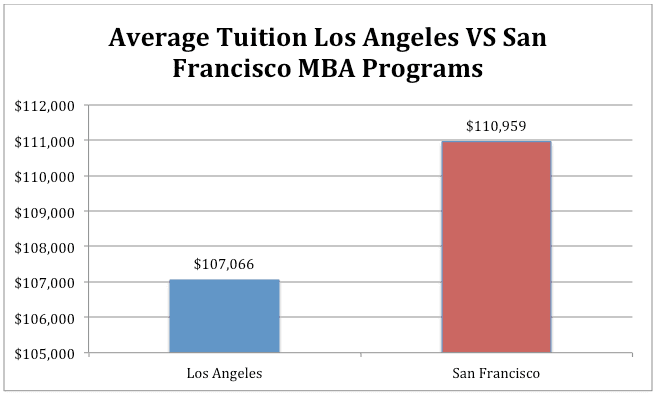
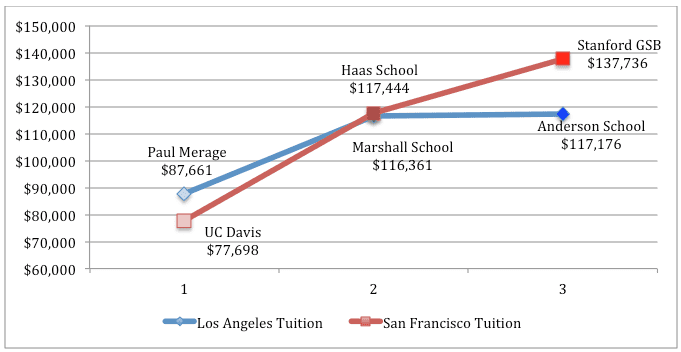
California MBA GMAT Averages
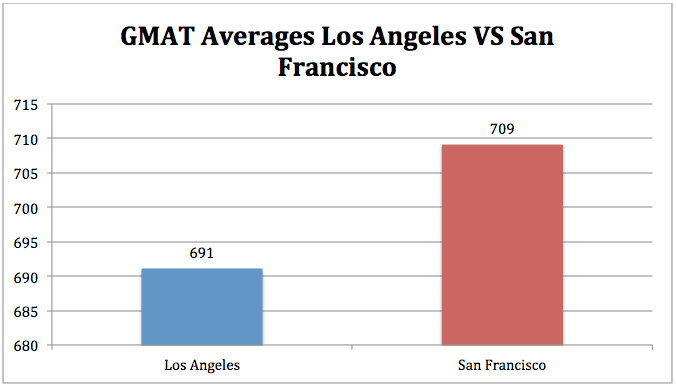
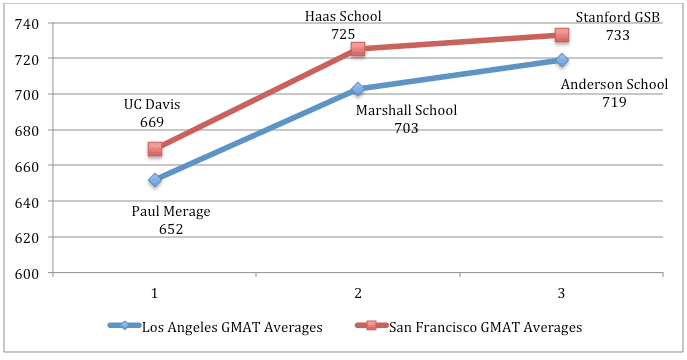
California MBA Post-Graduation Salaries
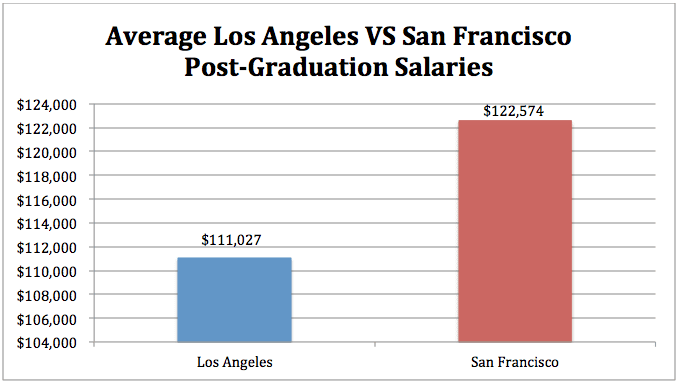
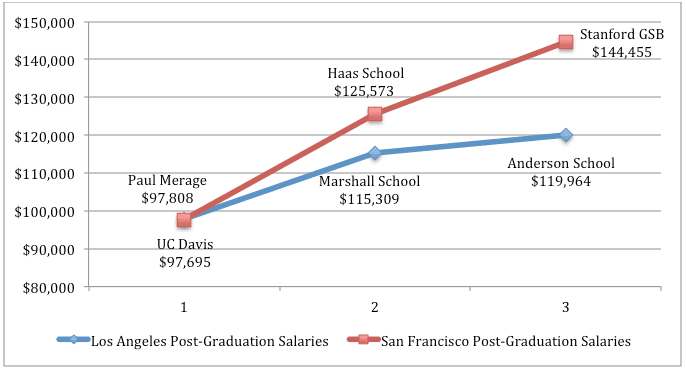
Berkeley Haas Celebrates 8 Years of Defining Leadership Principles

If you want to get a feel for the culture of UC Berkeley’s Haas School of Business, look no further than its four Defining Leadership Principles (DLPs): Question the Status Quo, Confidence Without Attitude, Students Always, and Beyond Yourself.
Introduced eight years ago, the DLPs have become a part of the fabric of the school. In fact, 75 percent of students from all three MBA programs and the undergraduate program cite them as a major reason they chose to attend. Not only that, 90 percent of Haas alumni surveyed from the past decade report being familiar with them and using them to navigate both their professional and personal lives. Earlier this month, as part of Haas Culture Day, the school celebrated the DLPs’ eighth birthday, complete with cupcakes.
In an interview with the Haas Newsroom, Dean Rich Lyons talked about the impact the principles he helped introduce have had on the school. “I’d say that we are seeing stronger data every year that the DLPs are affecting what we really care about. For example, we have clear data on how the Defining Leadership Principles are helping us win yield battles (i.e., when students choose Haas over other schools they’ve been admitted to). The DLPs are also motivating our donors. Alumni awareness of the principles is way up, and their engagement based on them is way up.”
To build on these successes, the school has launched a new initiative, the Haas Culture and Leadership Fund, designed to further extend the reach and impact of the DLPs even after Lyons steps down as dean to return to the faculty at the end of this academic year. Among other things, money from the fund will enhance culture-focused content in the curriculum; financial aid, awards, and research support for students and faculty who exemplify the DLPs; and support existing centers and institutes that uphold the principles.
Dean Lyons has a difficult time choosing which DLP most resonates with him. “It has always been hard for me to look at them as anything but a ‘system’ taken all together,” he said. “The one principle that still seems like it sets us apart the most externally versus our top competition is Confidence Without Attitude. But for me personally, the one resonating the most right now is Beyond Yourself. There’s so much in that one that it’s inexhaustible.”
Haas also reached out to its community to find out which DLP they preferred. See what they had to say in the video shared below.
This article has been edited and republished with permissions from our sister site, Clear Admit.
The QS World MBA Tour Is Coming To San Francisco

The QS World MBA Tour will be stopping in San Francisco on Sunday, January 28, 2018.
Potential graduate school applicants attending these events will have an opportunity to connect with alumni from many of the most prestigious schools in the world, including the likes of The Wharton School at the University of Pennsylvania, Harvard Business School, the Stanford Graduates School of Business, and much more.
Details on the event website read as follows:
“The QS World MBA Tour gives you the opportunity to network with admissions directors and alumni from over 120 business schools around the globe. Our fairs feature top local and international business schools presenting a diverse range of programs to choose from and a chance to apply for a pool of exclusive MBA scholarships, totaling $7m [million]! The QS World MBA Tour takes place in 23 cities across the US and Canada; find an event in a city near you and discover the many benefits that an MBA has to offer.”
Registration and further details for the San Francisco event can be found here. For those not in the metro, check out the rest of the QS World MBA Tour dates, listed below.
- Boston: Thursday, January 18, 2018 – 4:30 – 9 p.m.
- New York: Saturday, January 20, 2018 – 1:30 – 6 p.m.
- Washington DC: Tuesday, January 23, 2018 – 4:30 – 8:30 p.m.
- Chicago: Thursday, January 25, 2018 – 4:30 – 8:30 p.m.
- Los Angeles: Saturday, January 27, 2018 – 1:30 – 6 p.m.
- San Francisco: Sunday, January 28, 2018 – 1:30 – 6 p.m.
- Vancouver: Tuesday, January 30, 2018 – 4:30 – 9 p.m.
- Montreal: Thursday, February 1, 2018 – 4:30 – 9 p.m.
- Toronto: Saturday, February 3, 2018 – 1:30 – 6 p.m.
Registration and more information on the QS World MBA Tour events can be found here.
Berkeley Haas Opens Fall 2017 With Its Largest Full-Time MBA Class Ever and New Building
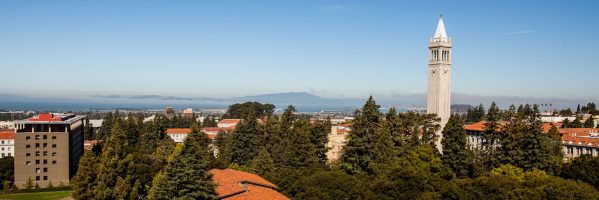
Like many top business schools this time of year, the Haas School of Business at the University of California at Berkeley is welcoming its incoming class of MBA students—but at Haas it’s a bigger group than ever before moving into brand-new digs that promise to be among the greenest in the nation.
There are 284 students in the entering class—32 more than last year—which brings what has long been the smallest leading business school more in line with some of its peers. Plans for next year include additional expansion, to a class size of 300. The grand opening of a new academic building—in progress for the past decade—made increasing the class size possible.
“The intimacy of the class is really an important part of what Haas is about,” Dean Richard Lyons acknowledged in a June interview with Clear Admit. But at just 250 students, where the school has hovered for many years, it has been a gross outlier—a mere third the size of Wharton and not even a third the size of Harvard. “Part of the reputation of the school is a function of its scale, and there are times where you are just not at the right reputational scale—you’re too small,” Lyons continued. “It’s a super intimate experience—there’s no question about that—but target companies want to go to a place where there are enough people graduating that they can send a team of recruiters, for example. If you are too small you are below the threshold.”
“We Don’t Want to Lose the Smallness That Makes Us Unique”
Precisely because the intimacy and close-knit nature of Haas is such an integral part of its culture, the administration, including the admissions team, has approached the process of increasing the class size carefully and thoughtfully. “I think people would be surprised by the amount of care that has been taken to consider potential ramifications,” Peter Johnson, assistant dean for the full-time MBA program and admissions, tells Clear Admit, adding that his team considered necessary adjustments of everything from budgets to graduate student instructors, program office staff to career coaches. “We have been very intentional about it because we don’t want to lose the level of smallness that makes us unique. A lot of our students were very concerned that it not change the experience for future students.”
Not only is the incoming class larger than any before it, it is also one of the strongest academically, Johnson says. Average GMAT scores and GPAs have risen over each of the past three years. The average GMAT score this year was 725—a jump from last year’s 717—and the average GPA climbed, too, from 3.64 to 3.71. Application volume also increased this past year, which meant that though the school admitted more students overall to increase class size, the acceptance rate remained constant at 12 percent. HBS, by comparison, generally accepts approximately 11 percent of its applicants.
The incoming class includes 40 percent women, up slightly over last year though still off from the record 43 percent that made up the Class of 2016. International students drawn from 42 different countries make up 39 percent of the class, up from 38 percent last year. Haas leads HBS, Wharton, and Kellogg in this metric, whose incoming classes are all around 35 percent international. Despite concerns that talk of potential immigration and visa reform under the current administration could have a chilling effect on international application volume, applicants from abroad applied in equal numbers this year as last, Johnson notes. U.S. minority students comprise 29 percent of the class, down from 32 percent last year.
In terms of what they did before coming to Haas, members of the Class of 2019 are an incredibly interesting bunch. Among them are a business development manager from Intel who led development of Google’s self-driving cars, an investment banker who ran from San Francisco to New York City over the summer to raise money and awareness of ALS in honor of his grandmother, a Bain consultant who earned four culinary diplomas in her spare time, a student from Nepal who helped senior political leaders and ex-ministers from five major parties negotiate a new constitution, and the founder and CEO of an Indian irrigation company that saves 4 billion liters of water annually while enabling smallholding farmers to produce 10,000 additional tons of food per year.
A quarter of the incoming students worked in consulting prior to Haas, and another 20 percent worked in finance. In terms of undergraduate degrees, 42 percent studied business or economics, 36 percent hold STEM degrees, and 8 percent graduated with degrees in the humanities.
“Top students from around the world with diverse backgrounds and amazing accomplishments continue to choose us for our distinctive culture,” Morgan Bernstein, executive director of full-time MBA admissions, said as part of an article on the Haas website. “No one else has the culture and community that we do.”
Can Chou Hall be the Greenest Academic Building in the U.S.?
The Haas Class of 2019 is the first to inhabit the newly opened Connie & Kevin Chou Hall, an 80,000-square-foot facility that boasts state-of-the-art classroom technology, flexible learning spaces, and features such as efficient heating, cooling, and lighting systems. These, in addition to rainwater cisterns and 24,300 square feet of exterior windows, helped it earn both LEED Platinum certification and WELL certification (an additional accolade applied to buildings that promote the health and well-being of their users).
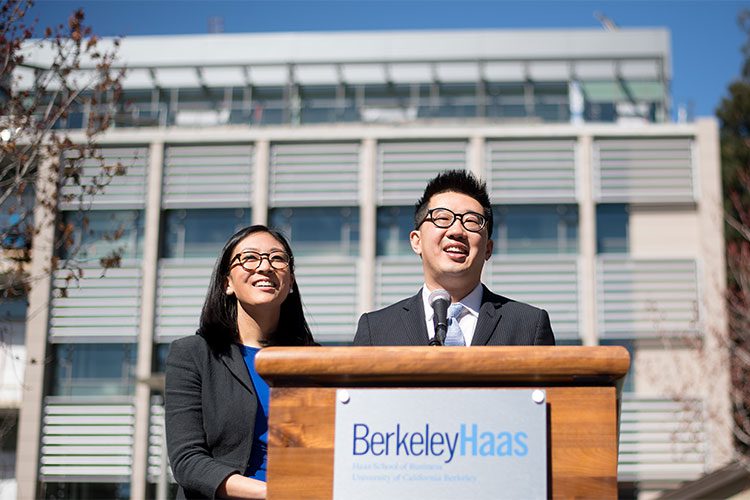
Kevin Chou and Dr. Connie Che appearing at the Berkeley Haas School of Business last March, after announcing their record-breaking school donation (Noah Berger/2017)
The building bears the name of Kevin Chou, BS ’02, founding CEO of mobile gaming company Kabam, and his wife, Dr. Connie Chen, in recognition of their $25 million donation, the largest to date from an under-40 alum. The remaining funds for the $60 million building also came entirely from alumni and friends of the school.
In addition to LEED Platinum and WELL certification, Chou Hall has been designed to divert 90 percent of waste—including through the mandatory use of reusable mugs and water bottles that can be replenished at filling stations and compost and recycling bins on every floor—which will allow it to achieve zero waste certification by summer 2018. This would make it the first business school in the country to do so.
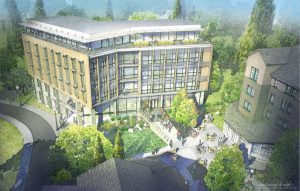
Early-stage concept art for the Connie & Kevin Chou Hall.
There are no places to dispose of other types of trash—encouraging those who use the building to adopt a “’pack-it-in, pack-it-out’ mentality,” according to Courtney Chandler, senior assistant dean and chief strategy and operations officer. “It might take a little getting used to, but we don’t think it will be hard for the Haas community—we’re all about questioning the status quo and redefining business-as-usual,” Chandler said in a story on the Haas website, referring to two of the school’s defining principles.
The building includes eight tiered classrooms and four flexible classrooms, totaling 858 new classroom seats, as well as 28 student and meeting rooms. This provided the much-needed additional space Haas required to expand its class size. A sixth-floor event space will open next month, and a café offering sustainable, locally sourced food—what else—is slated to begin serving students in early 2018.
This article has been edited and republished with permissions from Clear Admit.
